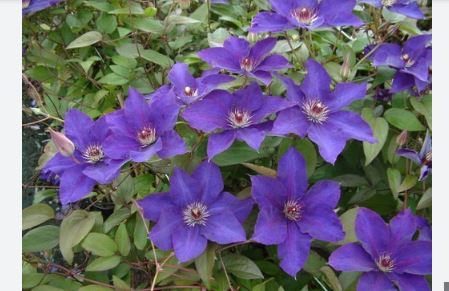
The President’ was bred by Charles Noble, a renowned clematis grower, in Sunningdale, England. It was introduced to the gardening world around 1876. It was named in honor of the president of the Royal Horticultural Society (RHS) at the time, reflecting the high esteem in which this cultivar was held or perhaps as a mark of respect or tribute to the horticultural community’s leadership. However, specific details about which president it was named after are not as commonly cited in horticultural records.
Over the years, ‘The President’ has remained popular due to its vibrant flowers, robust growth, and relatively easy cultivation. It has won several awards, including the RHS Award of Garden Merit, which signifies that it performs reliably in gardens.
Characteristics
- Flowers: ‘The President’ features large, star-shaped flowers that can grow up to 6-8 inches (15-20 cm) in diameter. The flowers are a deep blue-purple, with a slightly silvery undertone on the undersides of the petals. Each flower has 6 to 8 overlapping sepals. The center of the bloom is highlighted by reddish-purple anthers, adding contrast.
- Growth Habit: This clematis is a vigorous but not overly rampant climber, typically reaching heights of 8 to 12 feet (2.5 to 3.5 meters). It’s well-suited for growing on trellises, arches, fences, or through shrubs and small trees.
- Bloom Time: It blooms in late spring to early summer on old wood, with a second, often less profuse, flush of flowers in late summer on new growth.
- Foliage: The leaves are green, often with a somewhat pointed, oval shape, providing a good backdrop for the vivid flowers.
- Pruning Group: ‘The President’ belongs to Pruning Group 2, meaning it requires only light pruning. Prune after the first flush of flowers to encourage a second bloom, removing dead or weak stems in late winter or early spring.
Cultivation
- Sunlight: Prefers full sun to partial shade. While it can tolerate some shade, more sunlight leads to better flowering.
- Soil: Thrives in well-drained, fertile soil with a neutral to slightly alkaline pH. Adding compost or well-rotted manure at planting time can be beneficial.
- Watering: Keep the soil consistently moist but not waterlogged. Regular watering, especially in dry periods, supports vigorous growth and flowering.
- Planting: Plant with the crown 2-3 inches below the soil surface to encourage more shoots from the base and protect against clematis wilt.
- Support: Provide a sturdy structure for it to climb. ‘The President’ can cover a significant area, so ensure the support is strong enough to bear its weight.
- Mulching: Apply mulch around the base to keep the roots cool and retain soil moisture. This also helps in preventing weed growth.
- Fertilization: Feed with a general-purpose fertilizer in early spring and possibly a bloom booster after the first flowering to encourage the second bloom.
- Diseases: Susceptible to clematis wilt like many in its family. Good planting practices, adequate watering, and ensuring good air circulation can minimize risks.
- Winter Care: Although ‘The President’ is relatively hardy, in regions with harsh winters, protect the base with extra mulch or a protective cover after pruning.